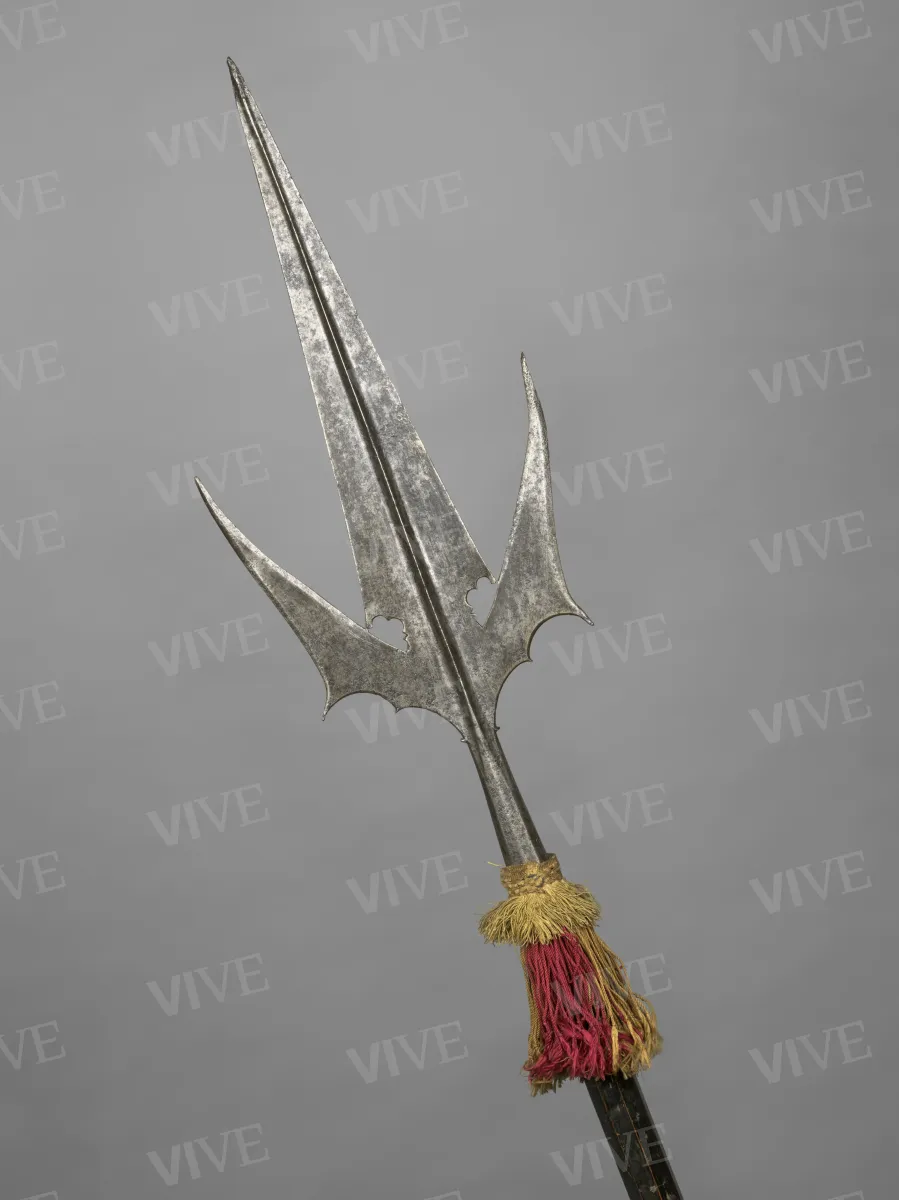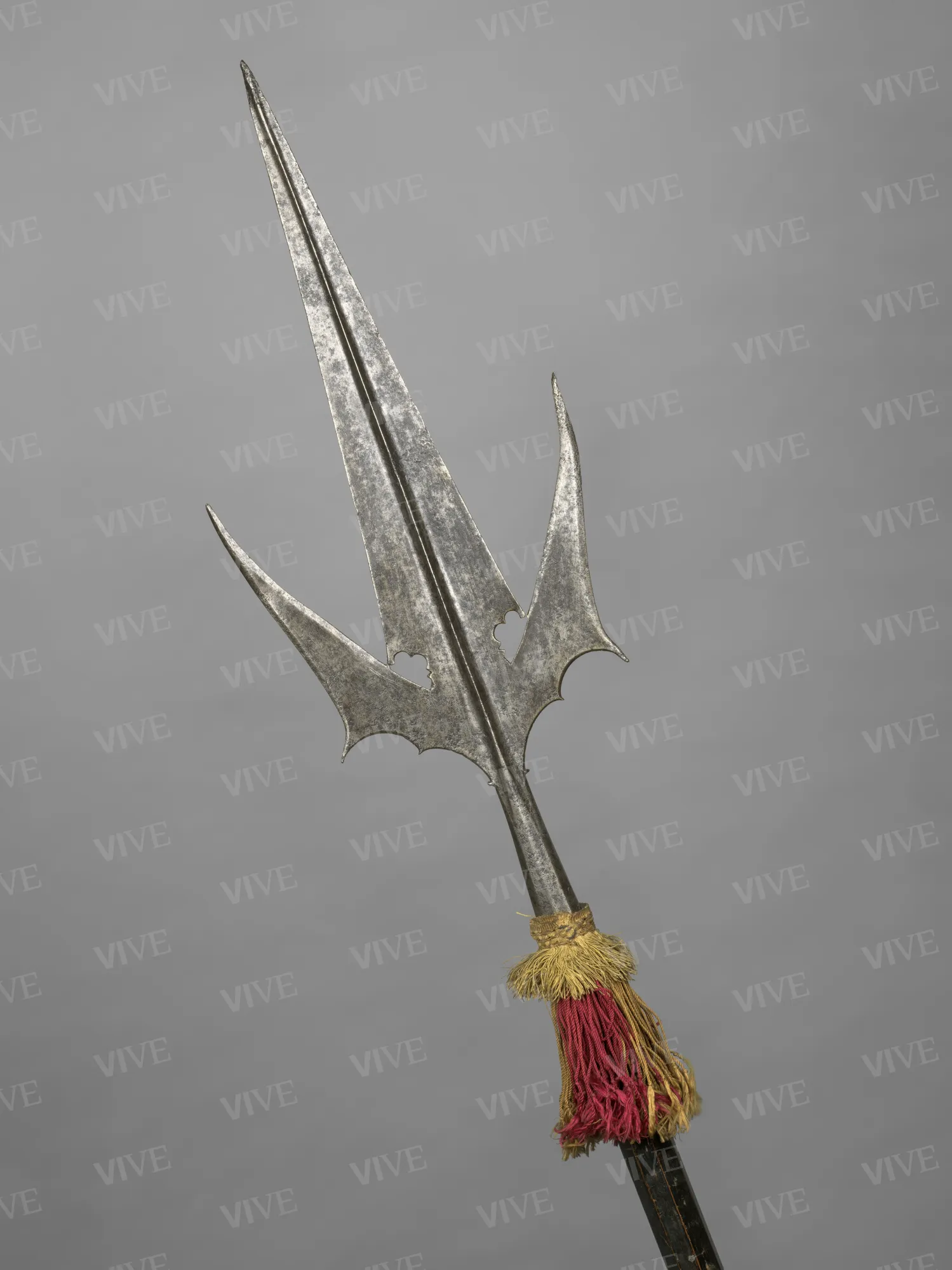Bat-winged corsesque or winged polearm.
Italian production 1500–1520
The corsesque is a bladed weapon that originated from the hunting polearm and is named after the island of Corsica, where it likely first appeared in this form. It consists of a spike with two pointed wings mounted on a long shaft. The corsesque was widely used in Italy from the late fifteenth century to the mid-seventeenth century due to its effectiveness in battle, owing to its sharp points and blades.
The corsesque is a bladed weapon that originated from the hunting polearm and is named after the island of Corsica, where it likely first appeared in this form. It consists of a spike with two pointed wings mounted on a long shaft. The corsesque was widely used in Italy from the late fifteenth century to the mid-seventeenth century due to its effectiveness in battle, owing to its sharp points and blades.
Details of work
Catalog entry
This corsesque comprises a long wooden shaft with a metal part attached, featuring a triangular ribbed central tip and two pointed wings with shaped lower edges on either side (from Carpegna 1969, 63, n. 374; from Carpegna 1976, 63). A red and yellow fabric tassel is present at the junction of the metal and wooden parts. The weapon is smooth, undecorated, and lacks an armorer’s mark. It shows signs of impact, particularly on the central cusp, and the tip of one of the two wings is slightly bent.
The corsesque, derived from the French “corsèque” (Corsican), is a bladed weapon likely originating in Corsica. It evolved from a hunting polearm and was popular between the fifteenth and seventeenth centuries. Known as the “corsesca palmata” or “bat-winged corsesque,” it features sharp, jagged side wings that made it effective in battle (Gelli 1900, 165–166; Waldman 2005, 177–182; Oakeshott 2012, 53).
Due to its substantial size, significant weight, and overall heft, it is presumed that this specimen was designed and utilized for warfare purposes rather than hunting, which required lighter and more maneuverable weapons (Scalini 2018, 128, n. IV.5).
This corsesque, though not marked by the armorer, can be associated with a group of weapons of similar craftsmanship, all attributed to Italian workshops from the early sixteenth century. Examples include one from the Zschille Collection at the Cleveland Museum of Art (Fliegel 1998, 168, n. 113) and those previously in the Riggs and Talleyrand-Périgord collections, now housed in the Metropolitan Museum in New York (inv. 14.25.197 and inv. 04.4.83).
The weapon belongs to the collection of Prince Ladislao Odescalchi (1846–1922), which was acquired by the Italian state in 1959 and transferred to the Palazzo Venezia in 1969. This extensive collection did not originate as a family armory but was instead the product of selective acquisitions from domestic (Florence, Rome) and international (Paris, London) markets beginning in the late nineteenth century (Barberini 2007). These purchases were guided by Odescalchi’s personal preferences.
Giulia Zaccariotto
Entry published on 12 June 2025
State of conservation
Fair.
Provenance
Collezione Ladislao Odescalchi (Odescalchi, no. 1538);
acquired by the Italian state, 1959;
Rome, Museo Nazionale di Palazzo Venezia, 1969.
Exhibition history
Rome, Museo di Palazzo Venezia, Antiche armi dal sec. IX al XVIII. Già Collezione Odescalchi, May–July 1969;
Rome, Museo Nazionale di Castel Sant’Angelo; Rome, Museo Nazionale di Palazzo Venezia, Armi e potere nell’Europa del Rinascimento, July 23–November 11, 2018.
References
Gelli Jacopo, Guida del raccoglitore e dell’amatore di armi antiche, Milano 1900;
di Carpegna Nolfo (a cura di), Antiche armi dal sec. IX al XVIII. Già Collezione Odescalchi, catalogo della mostra (Roma, Museo Nazionale di Palazzo Venezia, maggio-luglio 1969), con schede a firma del curatore, Roma 1969, p. 63, n. 374;
di Carpegna Nolfo, Le armi Odescalchi, Roma 1976;
Fliegel Stephen N., Arms and Armor: the Cleveland Museum of Art, Cleveland 1998;
Waldman John, Hafted Weapons in Medieval and Renaissance Europe: The Evolution of European Staff Weapons between 1200 and 1650, Leiden 2005;
Barberini Maria Giulia, La collezione Odescalchi di armi antiche: storia della raccolta del principe Ladislao, in «Bollettino d’arte», s. VI, XCI, 2006 (2007), 137/138, pp. 101-114;
Fossà Bianca, Studio conservativo delle armi e armature Odescalchi. Nuove metodologie per la schedatura di una collezione, in «Bollettino d’arte», s. VI, XCI, 2006 (2007), 137/138, pp. 115-142;
Oakeshott Ewart, European Weapons and Armour. From the Renaissance to the Industrial Revolution, Woodbridge 2012;
Scalini Mario (a cura di), Armi e potere nell’Europa del Rinascimento, catalogo della mostra (Roma, Museo Nazionale di Castel Sant’Angelo; Roma, Museo Nazionale di Palazzo Venezia, 26 luglio-11 novembre 2018), con schede a firma del curatore, Cinisello Balsamo 2018, p. 129, n. IV.6.












